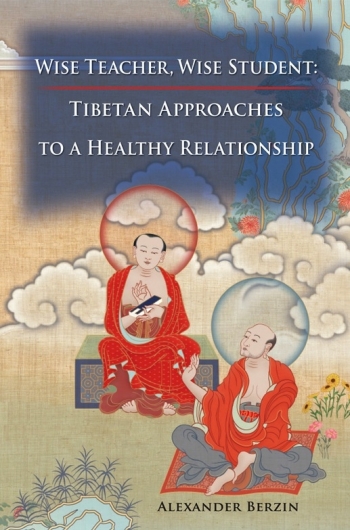 From shambhala.com
From shambhala.comWith respect to Buddhist teachers, which scenarios have you encountered? How much do you know about healthy versus unhealthy student-teacher relationships?
Maybe you have had or heard about experiences with Buddhist “teachers” who are unqualified, unauthorized to teach, self-proclaimed and unsupervised, and completely unprepared to be leaders. These despots exploit vulnerable students in the areas of sex and money and mislead them about the Dharma. Such teachers also often abuse drugs and/or alcohol. Many are Westerners, but some are Tibetans. They did not study long or diligently enough before declaring themselves to be “lamas” or “Rinpoches,” believing that the Dharma is theirs to change as they see fit despite having no realization, either stable or occasional.
The sanghas in which the students of these damaged teachers live then become the breeding grounds for cultishness, cliques, favoritism and more power grabs. Teachers and students alike manifest serious, unchecked psychological distress and social dysfunction. Almost no one is actually meditating, much less on a path to liberation. These individuals are terrible role models and should not be followed or emulated.
Or, perhaps you have been more fortunate and you have encountered qualified Buddhist teachers who are experienced in meditation, sadhana practices, sutras, and tantras, from having been trained and practiced meditation using a variety of methods for lengthy periods of time. These teachers, as students, have read, studied, and contemplated the teachings under the guidance of qualified teachers themselves, and are then singled out by their teachers as capable and ready to be spiritual instructors and mentors. The senior teacher, usually a “Rinpoche,” ordains/designates them as qualified to teach particular aspects of the Dharma and perhaps authorizes them to convey empowerments as well.
For particular advanced teachings, qualified teachers will carefully choose only those students who are ready to receive them, thus ensuring that the students will be capable of collaborating with each other to bring more beings into awareness. Excellent teachers are purely motivated to help liberate themselves and their students from samsara, working tirelessly to prepare the sangha members to support the liberation of all sentient beings.
The sangha members affiliated with a qualified teacher, then, are inspired and supervised by their teachers to work in harmony with each other, checking their behaviors and speech diligently so as to strive to support each other’s meditation practice in all ways. Beneficial teachers are “Spiritual Mentors,” worthy of our devotion and inspiring our highest aspirations as they catalyze and exemplify compassion, kindness, unconditional love, mutual respect, patience, diligence, commitment, generosity of spirit and resources, unflagging energy, and multi-layered bonds.
In Wise Teacher, Wise Student: Tibetan Approaches to a Healthy Relationship (Shambhala, 2010), author Alexander Berzin provides specific definitions, contexts, and situations for each of the types of instructors or teachers a Buddhist student may encounter. He then tells readers explicitly which ones to follow or study with, for what purposes. It was with great relief and confirmation that I recognized, from Berzin’s descriptions of healthy teacher-student relationships, that my own “Root Guru” is qualified and that his sangha is comprised of meditators who are functional and helpful.
 Alexander Berzin. From kunpendelek.ru
Alexander Berzin. From kunpendelek.ruWith a BA in Oriental Studies, Rutgers and Princeton Universities, and an MA/PhD in Far Eastern Languages (Chinese/Sanskrit) and Indian Studies from Harvard University, as well as decades of Tibetan Buddhist meditation practice and experiences of being close to highly qualified teachers of all types, including His Holiness the 14th Dalai Lama, Berzin is perhaps uniquely qualified to write such a book. Indeed, he has accomplished something extraordinary here: drawing upon his own experience as well as his studies, he has inserted his knowledge of both Tibetan and “Western” cultural constructs regarding teachers/teachings, students/disciples, respect, communication and spiritual friendships/relationships to provide an excellent guidebook to the student-teacher bond.
In Part I, “Spiritual Seekers and Spiritual Teachers,” Berzin uses the labels “spiritual seeker” and “spiritual teacher” as the most inclusive terms. In the first few chapters, he also gives many definitions and explanations of the etymologies of common terms, such as “guru” and “lama,” which help clarify the distinctions and designations he uses later to work well.
Starting with the most secular, the “Buddhism Professors” who teach “Students of Buddhism,” neither of whom is expected to actually practice Buddhism (although many do), he pairs each type of teacher with a particular label for the student based upon what the student can “receive” from that teacher. “Dharma Instructors” are next. These teachers work with “Dharma Pupils” to help them learn the sutras and the basics of practicing the Dharma.
To help one go further in becoming a Buddhist practitioner, a “Meditation or Ritual Trainer” guides a “Meditation or Ritual Trainee” through actual sadhana practices and their rituals and offerings. These “Trainers” also teach meditation techniques to approved “Trainees” who request them.
Berzin goes on to use “Spiritual Mentors” as the term for those who lead their “Disciples” along the path to “enlightenment,” with a subset of these labeled as “Refuge or Vow Preceptors.” These teachers are the ones who bestow vows, accept Refuge commitments, and teach about the meanings and rituals to their “Refuge or Vow Progeny.” He next explains that “Mahayana Masters” guide “Mahayana Disciples” to develop bodhichitta and follow the bodhisattva path, with a subdivision of these who focus on the tantric methods called “Tantric Masters,” who guide “Tantric Disciples.”
Finally, Berzin designates an individual who “can turn a seeker’s heart and mind most strongly to the Dharma” as one’s “Root Guru.” A Root Guru is not always found by every student, but is the most precious and sought-after type of teacher for sincere Dharma practitioners. I have heard that one’s “Root Guru” holds the key that opens a student’s heart, and I can testify to that myself.
The first time I saw my “Root Guru” walking into the Shrine Room, we had already spoken on the phone to establish that he was my teacher and we had known each other for about 15 years prior to this agreement. I certainly hadn't expected that the mere sight of him for the first time in his new role in my spiritual life would move me to tears and make my chest feel as though my heart could fly out of it.
Having guided us through definitions, Berzin then leads us through several possible ways these relationships can play out and the many purposes for our having such relationships. He focuses in Part II on “The Dynamics of a Healthy Student-Teacher Relationship,” providing readers with plenty of examples and methods for creating and maintaining our relationships in mutually beneficial ways.
My one complaint about the book is based on Berzin’s characterizations of motivations in several sections in Part III, “Unhealthy Relationships with Spiritual Teachers,” in which he seems to idealize Tibetan individuals over Westerners. I do not agree with some of his interpretations: for example, he attributes “community”-oriented rationales to Tibetans and elevates these as “better.” I disagree, because I believe that both Western and Tibetan students are usually attempting to get what we want from a student-teacher relationship for personal reasons.
Best aspects: Berzin is able to draw upon his many years of being in close proximity with renowned teachers, including His Holiness the Dalai Lama, because his main teacher was Tsenzhab Serkong Rinpoche, the late Master Debate Partner and Assistant Tutor of His Holiness. Berzin was able to spend time with both his teacher and the Dalai Lama.
Berzin must also have studied psychology extensively, because he writes expertly about the important issues of transference/counter-transference and other psychological issues that can arise for both teachers and students, Tibetans and Westerners, which are imperative to discuss and manage. I have encountered several teachers in my own decades of meditation who badly needed therapy and supervision as well as students who would have done better had they had many years of counseling before attempting to practice closely with a teacher.
Overall, this is a stellar volume filled with information and examples from scholarly texts, personal experiences, and historical and recent events to aptly illustrate each point. Berzin leads the reader clearly through the possible benefits and pitfalls in the key relationships for Buddhist practitioners: those with teachers. Every Buddhist student, of any school or lineage, would benefit from reading and referring frequently to this excellent resource.
Sally Ember, Ed.D., has been passionate about writing since she was nine, winning prizes for her poetry, stories, songs, and plays from a young age. Currently, she meditates, writes, swims, reads, and hosts her Google+ Hangout On Air (HOA) also on YouTube, *CHANGES*, LIVE conversations between authors, almost every Wednesday, 10–11 a.m. Eastern time, USA. She especially welcomes Buddhist writers and bloggers on her show! You can contact Sally on sallyember@yahoo.com or visit www.sallyember.com.
















